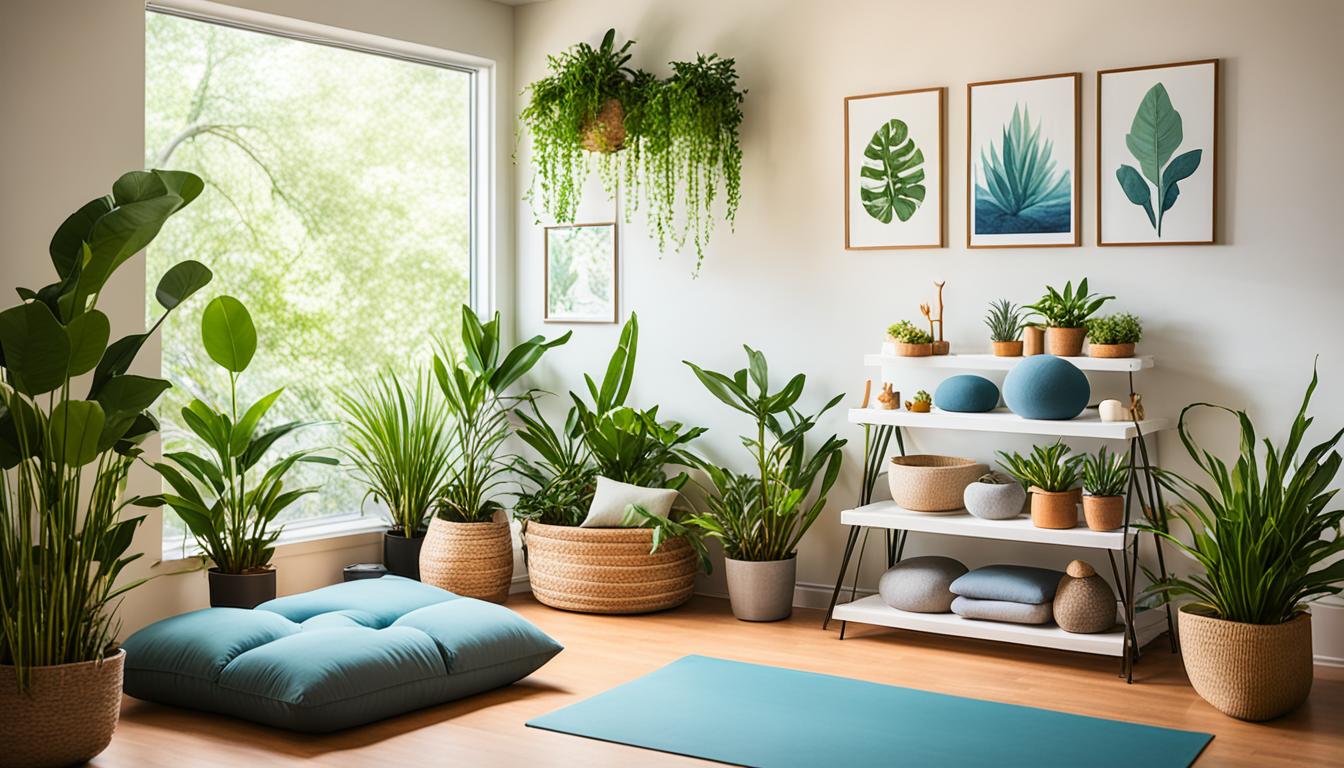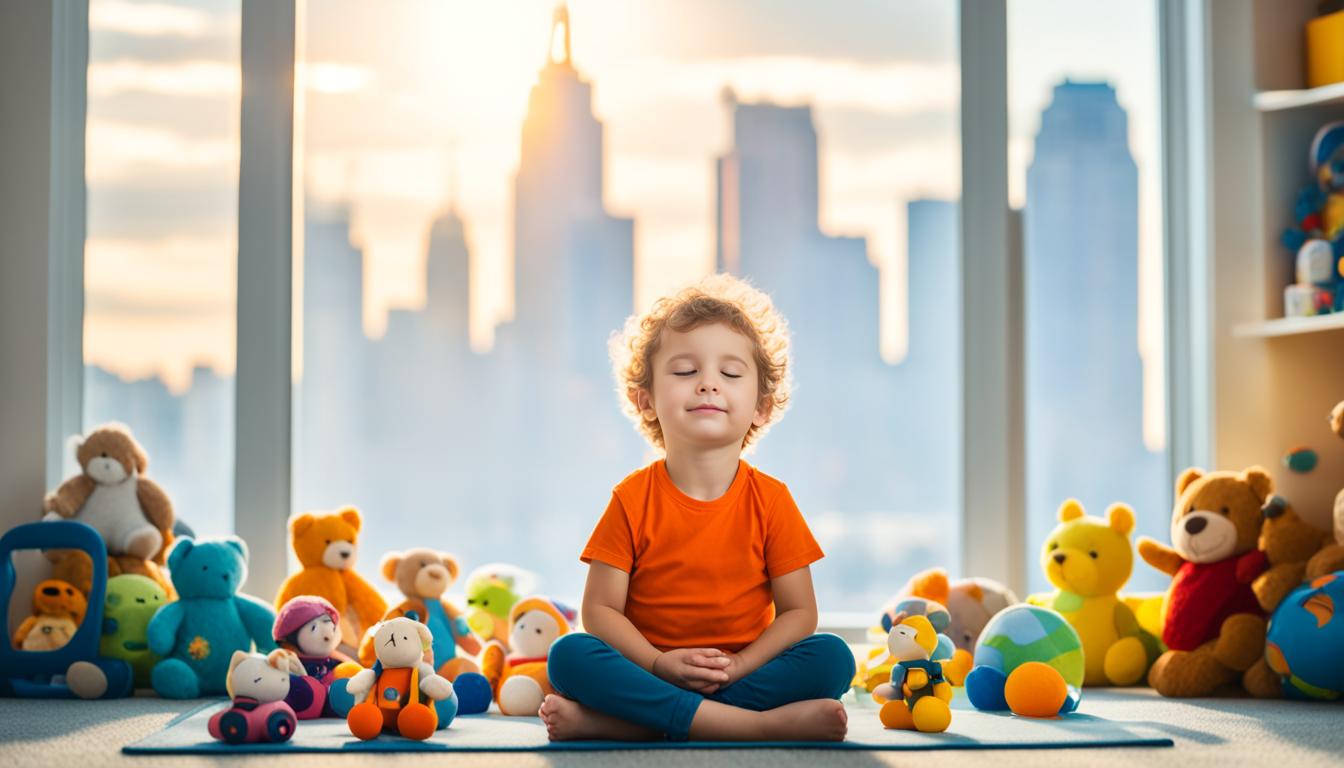Mindfulness is crucial for helping your children deal with stress and build emotional strength. It teaches them to focus on the now without judgment. This leads to better mental health. By learning mindfulness, kids gain tools to handle life’s ups and downs.
Studies show that mindfulness is now part of school programs for even the youngest kids. It helps them manage their feelings and deal with tough situations. It also lowers depression and anxiety and boosts focus and kindness. Simple exercises like visualization and sound meditation help kids control their emotions.
Teaching kids mindfulness introduces them to activities that make them appreciate life and understand their feelings. For example, enjoying food and listening to music can help. Creating a “mind garden” with positive thoughts or making art also supports mindfulness. We’ll explore fun ways to help your child grow through mindfulness.
Key Takeaways
- Mindfulness aids in reducing stress and emotional challenges in children.
- Simple mindfulness techniques promote better focus and attention.
- Creative activities can enhance mindfulness skills in young minds.
- Integrating mindfulness into daily routines fosters emotional awareness.
- Mindfulness practices also support gratitude and compassion.
Understanding Mindfulness and Its Importance for Kids
Every child faces numerous challenges as they grow, making it crucial to understand mindfulness. This practice involves focusing on one’s thoughts and feelings. It helps develop awareness, which is key to better emotional control. For kids, the benefits are immense, as they deal with stress from school, friendships, and everyday tasks.
These pressures can lead to increased stress and distractions, making it hard for them to concentrate. However, mindfulness can help alleviate these issues.
Studies show that mindfulness can improve attention and emotional health in children. For example, a study found that after eight weeks of mindfulness training, students in grades four through six felt less anxious and were more focused. These techniques give kids the tools they need to manage their emotions.
Now, mindfulness is becoming a part of both Special Ed and General Ed classes. Programs for teens with ADHD have seen significant positive changes. This shows that schools and homes are embracing mindfulness more and more.
By teaching kids about mindfulness, we set the stage for healthier emotional lives. These practices help them develop resilience and better focus. These are skills that will benefit them for the rest of their lives.
Mindfulness Techniques for Kids
Mindfulness techniques are vital for kids’ emotional and academic growth. They help children focus on the present, which is key when dealing with challenges. By learning mindfulness, kids not only manage their emotions better but also boost their overall health.
How Mindfulness Helps Kids Cope with Challenges
Teaching mindfulness gives kids the tools to tackle life’s hurdles with more strength. Through mindfulness, kids can lower stress, anxiety, and misbehavior, making it easier to face challenges clearly. They learn to accept their feelings without criticism, which helps them deal with challenges better. Moreover, mindful kids tend to participate more in class and interact better with others.
Executive Functions and Mindfulness
Mindfulness greatly aids children’s executive functions. These skills include managing attention, thinking flexibly, and remembering things. Regular mindfulness boosts these abilities, leading to better school performance and conflict resolution skills. Studies show that kids with stronger executive functions handle stress better, gain confidence, and interact positively with friends.
Simple Mindfulness Exercises for Children
Introducing simple mindfulness exercises for children helps them grasp their emotions and develop stress management skills. Practices like belly breathing and visualization are key. These activities not only aid in relaxation but also boost focus and security.
Introduction to Belly Breathing
Belly breathing is an excellent method for kids to engage with their breathing. They lie down, placing a small toy on their belly. Watching the toy move with each breath helps them find calmness. This method highlights the value of deep, conscious breathing, which aids brain function, especially in stressed or anxious children.
Including such exercises in daily routines can significantly improve emotional control.
Visualization Techniques: Creating a Safe Place
Visualization lets children craft mental images that offer comfort and security. They might imagine a “safe place” like a beach or a cozy room. This mental escape helps reduce stress when they feel anxious.
Such imagery fosters relaxation and self-acceptance. By practicing these techniques, children can shift from feeling overwhelmed to being more resilient. For more tips on mindfulness, check this resource.
Engaging Mindfulness Activities for Elementary Students
Incorporating mindfulness activities for elementary students can significantly boost their emotional regulation and social skills. The Mindful Jar and the Safari Walk are engaging ways for children to connect with their feelings and the world. These activities not only encourage mindfulness but also provide valuable tools for relaxation and awareness.
The Mindful Jar: Learning to Settle Emotions
The Mindful Jar offers a visual representation of how emotions can overwhelm us. By filling a jar with water, glitter, and glue, children create a captivating tool that illustrates the chaotic nature of emotions. Shaking the jar simulates the chaotic nature of emotions, while observing the glitter settle teaches kids to take deep breaths and calm their feelings. This activity empowers students to better recognize and manage their emotions effectively.
Safari Walk: Connecting with Nature
The Safari Walk invites students to step outside and connect with nature mindfully. During this activity, children practice observing sounds, sights, and scents around them, fostering appreciation for their environment. By paying attention to details, such as the rustling leaves or the chirping birds, students enhance their awareness and find peace in the present moment. This outdoor experience encourages a deeper connection to both nature and themselves, making it a refreshing and calming mindfulness activity.
Fun Mindfulness Practices for Young Children
Introducing young children to fun mindfulness practices can make self-awareness both enjoyable and accessible. Engaging in children’s mindfulness activities can include playful techniques that capture their attention and spark their imagination. For instance, consider incorporating a color breathing exercise, perfect for calming anxious or overexcited kids. This activity encourages children to visualize their breath as a specific color, promoting relaxation and focus.
Another engaging activity is using a simple bubble wand. Blowing bubbles can turn an ordinary day into a delightful mindfulness exercise. It teaches children to watch their breath and enjoy the joy of watching something float away. Such activities encourage kids to stay present while fostering a playful spirit.
Crafting activities like tape art collage are also excellent for expressing creativity and promoting calmness. As children create and manipulate materials, they practice being in the moment, enhancing their focus. Guided meditation apps like Calm can further enrich these experiences by offering structured methods for enjoying inner peace.
Exploring mindfulness exercises that connect with nature, such as nature walks, is beneficial. These activities allow children to appreciate their surroundings while learning to slow down and notice small details. Such practices not only improve attention but also help in emotional regulation, providing children with essential tools for their well-being.
Teaching Kids Mindfulness Through Play
Integrating mindfulness into play offers a dynamic approach to teach children vital skills. Activities that encourage mindful movement and awareness help kids grasp their bodies and the world around them. This method ensures learning is both enjoyable and effective.
Body Awareness Through Mindful Movement
Mindful movement, like yoga poses, is an excellent way to teach kids mindfulness. These exercises help children develop a deep understanding of their bodies. This awareness leads to a sense of calm, allowing them to identify and manage tension.
Incorporating these activities into play captivates children and teaches them valuable skills. These skills are crucial for emotional regulation and stress management.
Spidey-Senses: Enhancing Awareness
The “Spidey-Senses” exercise enhances children’s observational abilities, boosting their environmental awareness. Kids are prompted to notice their surroundings, much like a superhero using heightened senses. This activity stimulates their curiosity and promotes mindfulness.
By engaging in these exercises, children improve their ability to perceive their environment. This enhances their intuition and understanding of the world. Such experiences are vital for their cognitive and emotional development.
Mindfulness Games and Crafts for Creative Expression
Mindfulness games and crafts help kids delve into their emotions and stay in the moment. These activities teach them how to handle their feelings, which is key for their well-being. Making DIY Glitter Jars is a calming task that connects them with mindfulness. It’s a great way for kids to focus on the present and express their creativity.
DIY Glitter Jars as Mindfulness Tools
DIY Glitter Jars let children see their emotions in action. Shaking the jar shows how thoughts and feelings can calm down. This project is a fun way to practice mindfulness, showing kids that emotions change over time.
Watching the glitter settle teaches patience and staying in the moment. These crafts help kids talk about their feelings, making their emotional language richer. They learn to express emotions tied to the glitter inside the jar.
Artistic Activities to Promote Mindfulness
Activities like painting, coloring, and journaling are great for mindfulness and creativity. Projects like mandalas or art with essential oils boost creativity and engage the senses. These activities help kids focus on the now, improving their ability to stay present.
Through art, kids can direct their energy positively, which helps with managing emotions and growing their creative skills.
Integrating Mindfulness into Daily Routines
Creating a mindful atmosphere in your daily routine can significantly enhance your children’s mental well-being. By incorporating mindfulness into daily activities, you can reshape how they interact with the world. Simple practices, like breathing techniques, are incredibly effective, especially during snack time. These moments offer a chance to transition children from active play to a more focused state.
Breathing Techniques During Snack Time
During snack time, practicing breathing techniques can make children more aware of their bodies and feelings. Encourage them to take slow, deep breaths as they eat. This practice not only fosters calmness but also deepens their connection to eating. By focusing on their breath, children gain a better understanding of when they feel full and what their body needs.
Using Music to Foster Calmness
Incorporating music for calmness into daily routines can provide a soothing backdrop for various activities. Soft, instrumental music can help create an environment conducive to mindfulness. Consider playing calming tunes during snack time or before bedtime to promote relaxation. This approach reinforces positive moods and aids emotional regulation, helping children feel centered and more connected to their surroundings.
Encouraging Gratitude with Mindfulness
Incorporating mindfulness into your child’s routine can significantly enhance their emotional and mental well-being. Encouraging gratitude is a powerful way to promote a positive mindset. Activities like the three good things game can help children focus on the positive aspects of their day. This helps them appreciate moments of joy, even in tough times.
The “Three Good Things” Game
The three good things game encourages kids to think about their day and pinpoint three events or experiences that made them happy. This practice not only boosts thankfulness but also shifts their focus to the positive, fostering a more optimistic outlook. Regularly engaging in this activity helps children build resilience and emotional intelligence, leading to better overall well-being.
Thankfulness Practices at the Dinner Table
Starting a tradition of sharing thankfulness at the dinner table can further solidify these habits. Ask each family member to share something they’re grateful for during meals. This simple act helps children express their feelings, improving their social skills and emotional connection with others. Practicing gratitude in family settings like dinner nurtures mindfulness and strengthens bonds, making everyone feel valued and appreciated.
Creating a Mindfulness-Friendly Environment
Creating a space that supports children’s mindfulness is crucial. This area should be free from distractions, ensuring focus and an ideal setting for mindfulness exercises. Designate specific areas in your home for kids to relax and feel secure. Soft lighting, cozy seating, and calming colors create a peaceful setting that nurtures mindfulness.
Setting Up for Mindfulness Practice
To create a welcoming space for mindfulness, arrange items that bring tranquility. Incorporate cushions or mats for comfort and add calming scents or sounds. These elements help create an environment that supports emotional balance and self-awareness. Letting children help prepare enhances their commitment and enthusiasm. When they understand the setup’s importance, they dive into activities more deeply.
Involving Kids in Preparation and Activities
Getting kids involved in preparing and participating in activities boosts their ownership and enjoyment. Have them pick mindfulness tools like journals or fidget toys. This lets them take responsibility and develop mindfulness habits. It also builds a sense of belonging, empowering them to see mindfulness as a valuable skill. For more on prenatal mindfulness, check out additional resources here.

Mindfulness Techniques for Kids: Resources and Tools
Introducing mindfulness to kids relies heavily on the availability of resources. A broad array of engaging tools can significantly boost children’s grasp and practice of mindfulness. These tools include books that make learning mindfulness fun and accessible, guiding kids towards better emotional awareness and control.
Books and Apps Supporting Mindfulness
There are numerous mindfulness apps and books designed for young readers. Titles like *A Handful of Quiet* by Thich Nhat Hanh tell captivating stories that teach mindfulness through simple activities. These books often include activities that prompt kids to engage deeply and think about their feelings.
Apps such as *Headspace for Kids* and *Calm Kids* offer guided meditations suited for children. These apps help with focus and emotional control, making them great tools alongside hands-on practices like breathing and body awareness. Using these resources daily can help your child stay calm and mindful, enhancing their overall well-being.
Conclusion
The path to embracing mindfulness for kids is both rewarding and transformative. By using various practices, you help children face life’s challenges more easily. This approach also helps build a generation that values being present and self-aware. Studies indicate that mindfulness can improve focus, reduce stress and anxiety, and increase positive behaviors in kids.
Mindfulness helps kids connect with their feelings, understand them, and develop crucial coping skills. Activities like breathing exercises, nature walks, and the silence game can foster a peaceful atmosphere. This summary of mindfulness practices shows how these methods aid in emotional control and resilience. They also enhance empathy and self-awareness.
Adding mindfulness to daily life benefits both you and your children. Little Scholars underscores the importance of these practices. They not only boost happiness and inner peace but also foster lasting relationships. By prioritizing mindfulness now, we set the stage for a brighter, more mindful future for our children.
FAQ
What are some effective mindfulness exercises for children?
How can I implement mindfulness techniques for young children at home?
Why is teaching kids mindfulness important?
Are there any children’s mindfulness activities that can be done in a group setting?
How do mindfulness practices for kids support emotional development?
Can resources and tools help me teach mindfulness to my kids?
What role does gratitude play in mindfulness for children?
Source Links
- Top 10 mindfulness exercises for kids – https://www.bbcgoodfood.com/howto/guide/10-mindfulness-exercises-kids
- 25 Fun Mindfulness Activities for Children & Teens (+Tips!) – https://positivepsychology.com/mindfulness-for-children-kids-activities/
- 12 Mindfulness Activities for Kids – Cosmic Kids – https://cosmickids.com/mindfulness-activities-for-kids/
- The Power of Mindfulness – Child Mind Institute – https://childmind.org/article/the-power-of-mindfulness/
- Be Mindful to Stress Less (for Kids) – https://kidshealth.org/en/kids/mindfulness.html
- Mindfulness for Kids – https://www.mindful.org/mindfulness-for-kids/
- Mindfulness Exercises for Kids in the Classroom – Waterford.org – https://www.waterford.org/resources/mindfulnes-activities-for-kids/
- 5 Fun Mindfulness Activities for Kids – https://biglifejournal.com/blogs/blog/5-fun-mindfulness-activities-children-breathing-exercises
- Mindfulness activities for kids – Headspace – https://www.headspace.com/mindfulness/activities-for-kids
- 16 Mindfulness Activities for Kids That Are Fun and Teach Mindfulness – https://declutterthemind.com/blog/mindfulness-activities-for-kids/
- Quick + Simple Mindfulness Activities for Kids in the Classroom – https://www.teachstarter.com/us/blog/classroom-mindfulness-activities-for-children-us/
- 57 Simple Mindfulness Activities for the Classroom – https://www.weareteachers.com/mindfulness-activities-for-kids/
- 8 Mindfulness Activities & Exercises for Kids – https://www.luriechildrens.org/en/blog/ight-mindfulness-activities-to-try-at-home-with-kids/
- 20 of the Best Mindfulness Activities for Kids in 2022 – https://www.moshikids.com/articles/20-of-the-best-mindfulness-activities-for-kids-in-2022/
- 25 Mindfulness Activities for Kids That Will Keep Them from Bouncing Off the Walls – Vista Del Mar – https://vistadelmar.org/2021/03/19/25-mindfulness-activities-for-kids-that-will-keep-them-from-bouncing-off-the-walls/
- Kids’ Mindfulness Activities: Fun, Focus & Stress Relief – ABF Creative – https://www.abfc.co/kids-mindfulness-activities-fun-focus-stress-relief/
- Mindfulness in the Classroom – Child Mind Institute – https://childmind.org/article/mindfulness-in-the-classroom/
- Guided Mindfulness for Kids: Techniques and Benefits – ABF Creative – https://www.abfc.co/guided-mindfulness-for-kids-techniques-and-benefits/
- 20 Mindfulness Art Activities | Lightly Sketched | Orangeville – https://lightlysketched.com/2022/05/20/20-mindfulness-art-activities/
- 24 Fun Mindfulness Activities And Games For Kids – https://www.momjunction.com/articles/mindfulness-activities-for-kids_00487342/
- Mindfulness and SEL Activities For Kids to Manage Emotions – S&S Blog – https://www.ssww.com/blog/mindfulness-and-sel-activities-for-kids-to-manage-emotions/
- Ways to Teach Mindfulness to Kids and Families – https://cookcenter.org/ways-to-teach-mindfulness-to-kids-and-families/
- 5 Ways to Incorporate Mindfulness into Your Child’s Daily Routine – https://www.parent.com/blogs/conversations/2024-5-ways-to-incorporate-mindfulness-into-your-childs-daily-routine
- 7 Simple Ways to Introduce Gratitude and Mindfulness to Your Kids – Begin Learning – https://www.beginlearning.com/parent-resources/gratitude-and-mindfulness-for-kids/
- Heartwarming Mindfulness Activities – Gratitude Gift – Blissful Kids – https://blissfulkids.com/heartwarming-mindfulness-activities-gratitude-gift/
- Mindfulness for Kids: A Guide to Cultivating Calm and Focus : Kumarah – https://kumarahyoga.com/mindfulness-for-kids-a-guide-to-cultivating-calm-and-focus/
- Mindfulness for Kids – https://balanceapp.com/blog/cultivating-mindfulness-for-kids
- Mindfulness for Children – Barre Center for Buddhist Studies – https://www.buddhistinquiry.org/article/mindfulness-for-children/
- Empower Your Child with Mindfulness: 5 Techniques to Try Today – C-Suite Network™ – https://c-suitenetwork.com/empower-your-child-with-mindfulness-5-techniques-to-try-today-2/
- Mindfulness and Relaxation Techniques for Preschoolers | Little Scholars – https://littlescholarsnyc.com/mindfulness-and-relaxation-techniques-for-preschoolers/
- 5 Practical Strategies for Cultivating Mindfulness in Children | Life Enrichment Counseling Center, Inc. – https://lifeenrichmentcounseling.com/5-practical-strategies-for-cultivating-mindfulness-in-children/


